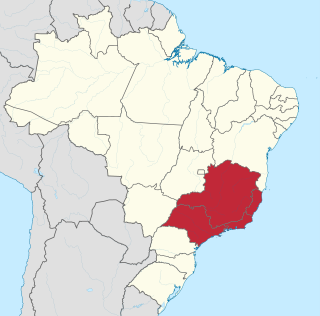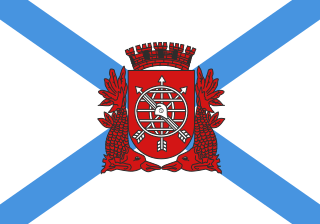Related Research Articles

Rio de Janeiro, or simply Rio, is anchor to the Rio de Janeiro metropolitan area and the second-most populous municipality in Brazil and the sixth-most populous in the Americas. Rio de Janeiro is the capital of the state of Rio de Janeiro, Brazil's third-most populous state. Part of the city has been designated as a World Heritage Site, named "Rio de Janeiro: Carioca Landscapes between the Mountain and the Sea", by UNESCO on 1 July 2012 as a Cultural Landscape.

Rio de Janeiro is one of the 27 federative units of Brazil. It has the second largest economy of Brazil, with the largest being that of the state of São Paulo.
Carioca is a demonym used to refer to anything related to the City of Rio de Janeiro as well as its eponymous State of Rio de Janeiro, in Brazil. The original word, "kara'i oka", comes from the indigenous Tupi language meaning "house of carijó", which was a native tribe of Rio de Janeiro who lived in the vicinity of the Carioca River, between the neighborhoods of Glória and Flamengo.

José Maria da Silva Paranhos Jr., Baron of Rio Branco was a Brazilian diplomat, geographer, historian, monarchist, politician and professor, considered to be the "father of Brazilian diplomacy". He was the son of statesman José Maria da Silva Paranhos Sr. The Baron of Rio Branco was a member of the Brazilian Academy of Letters, occupying its 34th chair from 1898 until his death in 1912. As a representative of Brazil, through his diplomacy, he managed to peacefully resolve Brazil's border disputes with its South American neighbours

Duque de Caxias is a city on Guanabara Bay and part of Rio de Janeiro metropolitan area, being the third most populous in Rio de Janeiro state, southeastern Brazil.
The sixth edition of the South American Championship was scheduled to be held in Chile, but Brazil asked to host it as part of its 100th anniversary independence celebrations. Thus it was held in Rio de Janeiro between September 17 and October 22, 1922.

The Southeast Region of Brazil is composed by the states of Espírito Santo, Minas Gerais, Rio de Janeiro and São Paulo. It is the richest region of the country, responsible for approximately 60% of the Brazilian GDP. São Paulo, Rio de Janeiro, and Minas Gerais are the three richest states of Brazil, the top three Brazilian states in terms of GDP. The Southeast of Brazil also has the highest GDP per capita among all Brazilian regions.

Nova Iguaçu is a municipality in Rio de Janeiro state in Brazil.
Maracanã most commonly refers to the Maracanã Stadium in Rio de Janeiro, Brazil. It may also refer to:
Rio Branco or Río Branco may refer to:

The Rodovia Presidente Dutra,, colloquially known as Via Dutra is a federal highway which runs through the eastern part of the state of São Paulo and southwestern region of the state of Rio de Janeiro. It is the part of BR-116 connecting the city of São Paulo to the city of Rio de Janeiro.

Purian is a pair of extinct languages of eastern Brazil:

Itaboraí is a city in the state of Rio de Janeiro in Brazil, that belongs to the Rio de Janeiro metropolitan area. It was founded in 1672. In 2018, it had a population of 238,695.

Japeri is a municipality in the state of Rio de Janeiro, southeast region of Brazil. This city was founded on June 30, 1991. Is very known to be located next to the last station of the largest branch of the railroad of Brazil, whose image has been stamps in Brazil. The construction date of 1858 and was incorporated into the Central do Brasil in 1903. It was the first stop of compositions for São Paulo, including the famous Trem de Prata.

Lapa is a neighborhood in the city of Rio de Janeiro, in Brazil. It is located in the centre of Rio and is famous for its historical monuments and nightlife.

The Maracanã River of Rio de Janeiro, which means parrot-like in Tupi–Guarani, is a river located in Rio de Janeiro state in southeastern Brazil.

Brazil has competed at every edition of the Pan American Games since the first edition of the multi-sport event in 1951.

Pavuna is a neighbourhood in the North Zone of Rio de Janeiro, Brazil. It is one of the oldest places in Rio de Janeiro city.

Events in the year 1947 in Brazil.

The following outline is provided as an overview of and topical guide to Rio de Janeiro:
References
| This article related to a river in Rio de Janeiro state, Brazil is a stub. You can help Wikipedia by expanding it. |